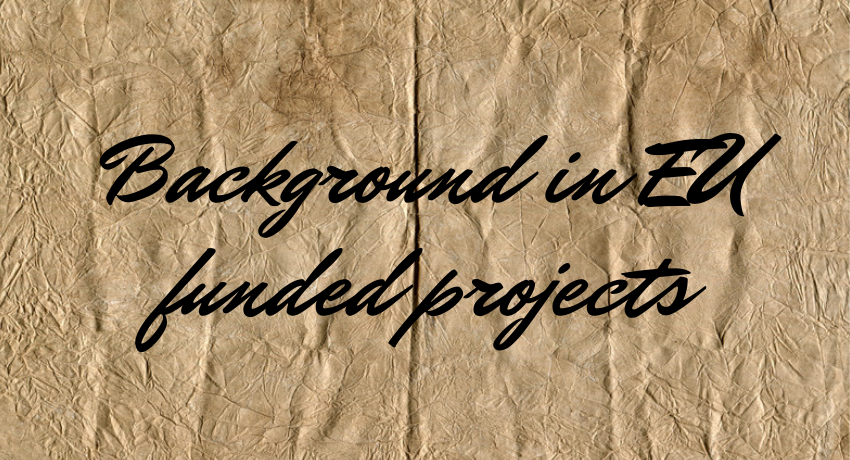
What can be considered as background in EU-funded projects?
This is a question that we receive every so often at the Helpdesk. Please, find here a few key answers related to this question.
The first thing you need to do is check the definition of Background included in your Grant Agreement, as not all types of EU funding use the exact same definition. For the sake of simplicity, we will base this article on the definition of background provided in the Model Grant Agreement for Horizon 2020 projects.
In Horizon 2020, background is not only limited to IPR. Indeed, if you take a look at the definition of background (article 24.1 of the AMGA - https://ec.europa.eu/research/participants/data/ref/h2020/grants_manual/amga/h2020-amga_en.pdf) “background means any data, know-how or information, whatever its form or nature (tangible or intangible) including any rights such as IPR that: is held by the beneficiary before they acceded to the Agreement, and is needed to implement the action or exploit the results”. Therefore, background can take many forms, not only the form of intellectual property rights, it could be information, databases, tangible assets, trade secrets, know-how...
The same article 24 of your Grant Agreement requires you to identify and agree, in writing, on the background for the actions.
So, what should be included in this list?
Any data, know-how, information or rights, such as IPRs, that: are held by a beneficiary BEFORE they sign the GA and are needed to implement the action or exploit the future results.
Can you use information that has been generated in another EU-funded project?
The definition provided above is rather broad - meaning that, in principle, data of other related EU projects could be considered as background, as long as:
- it was generated before the starting date of your current project;
- it is held by one or several of the current project beneficiaries (owned by them, or licensed to them) - meaning that they have a right to bring it as background;
- AND it is held / owned in a way that allows them to use it in the current project. So here you would need to check whether there are previous obligations or interests to keep this data confidential (obligations stemming from the previous project), and act accordingly. It is for example possible to bring confidential datasets as background to a new project, but then the respective owner / holder should ensure that confidentiality is maintained in this new project (e.g. make the use of the datasets subject to specific confidentiality obligations, if relevant and needed).
Should you list as background something that you own and you will be the only one to use? is it better not to list it to prevent unnecessary access to it?
By definition, something that is not needed by anyone for the action is not background. If YOU need to use something that you own in order to implement your tasks under the action, then this constitutes your own background – since you will personally bring it to the table and work with it during the action. Accordingly, this should be listed as your background if it is the main tool you will be needing and using, and if it is the very reason why you got involved in this project.
If other partners do not need access to it, they will not be able to claim access rights to it. In other words: just because you list something as background does not mean that you grant an open authorisation for partners to access it. The definition of Background and the GA provisions on access rights to background (see article 25 GA) are restrictive and make it very clear that only access rights requests that are needed have to be complied with.
That is at least how it should be done in principle, and this "need" requirement is the basic instrument to protect your own background from unnecessary access. While complying with the GA, you can also:
- List your tool/IP/information as background, complying with the obligation set out by the GA;
- inform other partners that, while this is your background, it is excluded from access. Exclusions are allowed under H2020 rules and may be justified in certain cases: if the tool/IP/information will not be needed by others, excluding it from access would not be prejudicial to project implementation.
Are exclusions allowed in Horizon2020?
Yes, as mentioned above, you can exclude specific background for a limited time or for the entire lifespan of the project, exclude access to specific partners only etc. Please see on that topic the examples provided by the Commission in the annotated model GA (page 233). Note however that other beneficiaries should be informed about the exclusion before signing the GA.
However, take into account that exclusions are somehow “tricky” and should be used with caution. As the EC notes, since Background is by definition "needed", the impact of any exclusion should be examined by the beneficiaries since it may hinder implementation or exploitation. Remember that the very core of EU-funded projects is sharing knowledge.
How is it going to be in Horizon Europe?
As far as we can see based on the general model grant agreement published so far, the main principles will still remain valid for background in Horizon Europe projects. The definition of background remains the same as in H2020 (see article 16.1), the obligation to agree on it in writing still exists, and the default conditions for access rights to background are the same as in H2020 too (see Annex 5 – Specific Rules on IPR).
Further guidance will come from the EC when the annotated model GA for Horizon Europe is published – we will keep you posted!
Details
- Publication date
- 29 June 2021
- Author
- European Innovation Council and SMEs Executive Agency
